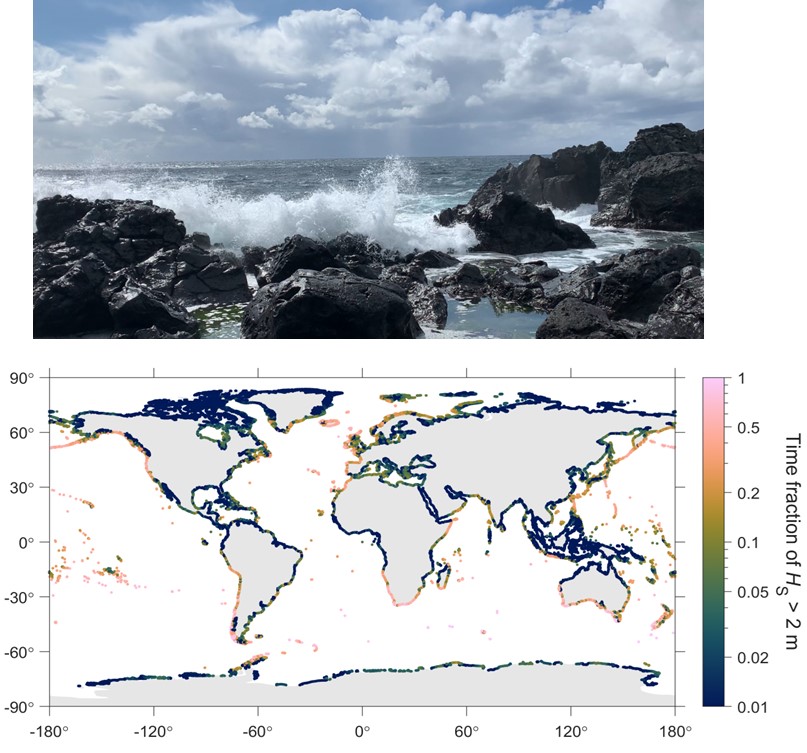When waves meet the shore: strong production of sea spray aerosols from shoreline wave breaking
Submitter
Wang, Jian — Washington University in St. Louis
Area of Research
Aerosol Processes
Journal Reference
Zhou S, M Salter, T Bertram, E Brito Azevedo, F Reis, and J Wang. 2025. "Shoreline wave breaking strongly enhances the coastal sea spray aerosol population: Climate and air quality implications." Science Advances, 11(35), 10.1126/sciadv.adw0343.
Science

Upper: Sea spray aerosol generation from the shoreline wave breaking at the Graciosa Island, Azores (Credit: Jian Wang). Bottom: The time fraction of high-wave periods (significant wave height HS > 2 m) from 2013 to 2022 along global coastlines, indicating the spatial distribution of coastal regions potentially with strong impacts of shoreline SSA production (image from the paper).
Leveraging ARM’s long-term atmospheric observations from three coastal sites along with global ocean wave data sets, we found that the breaking of ocean waves near shorelines can generate large amounts of both tiny and large aerosol particles. We also quantified how much this process boosts coastal aerosol levels and discussed the implications for understanding the effects of sea spray aerosols on global climate and coastal air quality.
Impact
Strong shoreline wave breaking is a widespread phenomenon along global coastlines and can substantially increase both the number of cloud condensation nuclei (CCN) and the mass of airborne particles in coastal regions. This has two major implications: (1) Studies that rely on coastal measurements to represent open-ocean conditions may significantly overestimate SSA’s contribution to CCN and by extension, its effects on clouds and climate. (2) Regional air quality models that do not account for shoreline-driven aerosol production likely underestimate the impacts of SSA on coastal air quality and public health.
Summary
Sea spray aerosol (SSA) emission is a major source of atmospheric aerosols, but its influences on global climate and coastal air quality are not fully understood. Previous studies often relied on coastal observations to represent open-ocean SSA, but whether and when these observations near the shoreline accurately represent open oceans remain unclear. Here, we show that the wave breaking near the shoreline, governed by wave energy rather than local wind speed, is a strong SSA emission source and can greatly enhance downwind cloud condensation nuclei (CCN) and aerosol mass concentrations. Strong shoreline wave breaking is widespread globally, and swell waves, which are decoupled from local winds, play a dominant role in many coastal regions. Therefore, extrapolating results based on coastal measurements to open oceans may significantly overestimate SSA concentration and its contribution to CCN and, by extension, the impact of SSA on clouds and climate. Additionally, shoreline SSA generation can transfer seawater pollutants into the atmosphere and affect air quality. Current regional models, which do not parameterize nearshore SSA generation using wave energy or completely neglect it, likely underestimate its potential environmental impacts on coastal communities.
Keep up with the Atmospheric Observer
Updates on ARM news, events, and opportunities delivered to your inbox
ARM User Profile
ARM welcomes users from all institutions and nations. A free ARM user account is needed to access ARM data.


















